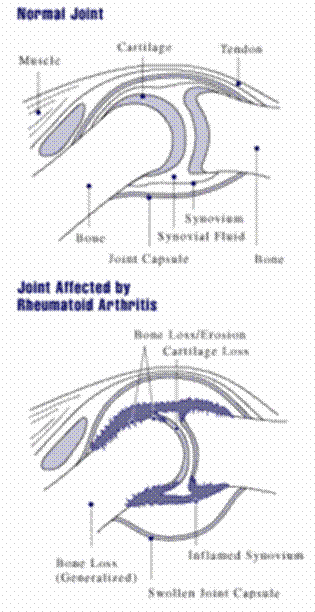
Rheumatoid arthritis, sometimes referred to as rheumatoid disease, is a chronic (long lasting), progressive and disabling autoimmune disease that causes inflammation (swelling) and pain in the joints, the tissue around the joints, and other organs in the human body. Rheumatoid arthritis usually affects the joints in the hands and feet first, but any joint may become affected. Patients with rheumatoid arthritis commonly have stiff joints and feel generally unwell and tired.
Rheumatoid arthritis is an autoimmune disease. Our immune system is a complex organization of cells and antibodies designed to seek out and destroy organisms and substances which harm us, such as infections. When our immune system starts attacking our own bodies, mistaking body tissues for foreign invaders, we have an autoimmune disease.
Individuals with an autoimmune disease have antibodies in their blood which target their own body tissues, resulting in inflammation. The immune system of a patient with rheumatoid arthritis attacks the lining of the joints, causing them to swell (become inflamed). As opposed to the wear-and-tear damage which occurs with osteoarthritis, rheumatoid arthritis affects the lining of the joints, resulting in painful swelling that can lead to bone erosion and joint deformity. Eventually the affected joints may become permanently damaged.
Rheumatoid arthritis is referred to as a systemic illness. Systemic means it affects the entire body; in the case of rheumatoid arthritis, multiple organs in the body can be affected. The patient may also have fevers and experience fatigue. Rheumatoid arthritis may also produce diffuse (spreading) inflammation in the lungs, the membrane around the lungs (pleura), pericardium (a double-walled sac that contains the heart and the roots of the great blood vessels) and the tough white outer coat over the eyeball (sclera); it can produce nodular lesions, most commonly in subcutaneous tissue under the skin.
Patients with rheumatoid arthritis have a significantly higher risk of having a heart attack, compared to other people.
- According to The National Health Service (NHS), UK, about 350,000 British people are affected by rheumatoid arthritis.
- According to the National Rheumatoid Arthritis Society (UK) rheumatoid arthritis affects 0.8% of the UK population.
- According to The Mayo Clinic, USA, the disease is two to three times more common in women than in men.
- Although people of any age may be affected, rheumatoid arthritis is much more common after the age of 40. According to the National Rheumatoid Arthritis Society (UK), approximately 12,000 children under 16 years of age have a juvenile form of the disease.
- According to the John Hopkins Arthritis Center, USA:
- Approximately 1% to 2% of the world’s population is affected by the disease.
- Prevalence increases with age, approaching 5% in women over 55 years of age.
- Annual average incidence is 70 in every 100,000 in the USA. It is 4 times more common in smokers than non-smokers.
Rheumatoid arthritis is much more common that MS (multiple sclerosis) or leukemia. However, awareness of the disease’s effects and severity are more restricted to patients, their caregivers and their relatives because it is not well publicized.
Rheumatoid arthritis symptoms generally come and go. On some occasions symptoms may be mild, while on others they may be severe and extremely painful. A patient has a ”flare up” when symptoms are bad. It is impossible to know when a flare up may come.
Rheumatoid arthritis can be a very painful condition, leading to considerable loss of functioning and mobility. Diagnosis is made chiefly as a result of identifying signs and symptoms, as well as rheumatoid factor blood tests and X-rays. Diagnosis and the long-term management of the disease is generally carried out by a rheumatologist; a specialist in rheumatology.
Although the disease has no cure, early diagnosis and prompt subsequent treatment of symptoms may slow the progression down, as well as making the patient more comfortable.
No comments:
Post a Comment